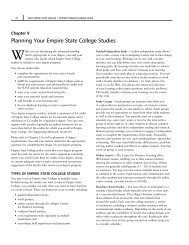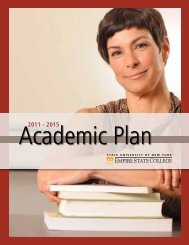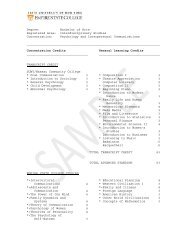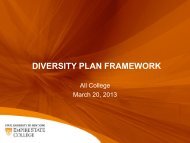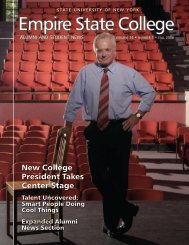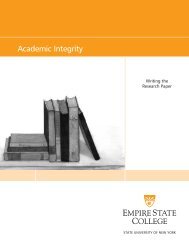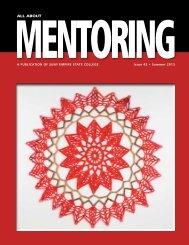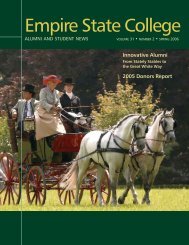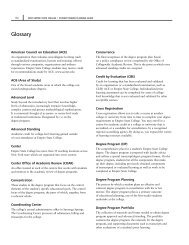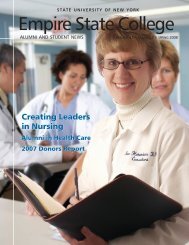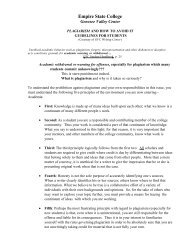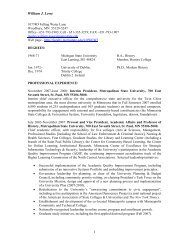All About Mentoring Spring 2011 - SUNY Empire State College
All About Mentoring Spring 2011 - SUNY Empire State College
All About Mentoring Spring 2011 - SUNY Empire State College
You also want an ePaper? Increase the reach of your titles
YUMPU automatically turns print PDFs into web optimized ePapers that Google loves.
23<br />
intrinsic effort to self-protect. One comment<br />
was, “I don’t know if I was scared or if I<br />
just felt if I was doing something toward<br />
being a better person that this would go by<br />
quicker or faster, or make it alright. But I<br />
just knew I needed to get in on that … ”<br />
Another said, “I was nervous,” and yet<br />
another commented that “I was actually<br />
fearful of college at first until I got in<br />
there to see it wasn’t that bad.” As each<br />
interview progressed, the dialogue about the<br />
learning process, as a whole, intensified. In<br />
Schuante’s words:<br />
I couldn’t wait, I had to stay at [the<br />
maximum-security unit] for a year … if it<br />
wasn’t for me coming in here and getting<br />
this now, then I would get out and go<br />
right back and do the same thing [that<br />
got me here before]. I needed to take a<br />
look at myself, because apparently I was<br />
not doing things right, and as long as I<br />
continued on this same path, it was going<br />
to take me to the same place – prison or<br />
death, or maybe both.<br />
At this juncture in their stories, none of<br />
the women articulated an understanding<br />
of the significance of their decisions to<br />
be in college beyond the desire to avoid<br />
temptation in order to change their<br />
direction in life. Patterns emerged from the<br />
interviews illustrating their processes for<br />
reorienting their earlier learning experiences<br />
and self-protecting to strengthen their<br />
success. School provided a buffer against<br />
the troublemakers, and it helped to create<br />
a subset of like-minded women who could<br />
support one another in positive ways.<br />
By avoiding controversy, and caring and<br />
supporting others, they contributed to their<br />
own “holding environments,” defined by<br />
Kegan (1982) as a supporting or “amniotic”<br />
internal environment (p. 140) where one is<br />
safe to evolve and to let go.<br />
Gaining Voice From Learning<br />
These women found an internal place of<br />
safety for learning where they began the<br />
process of growing and changing. They<br />
began to trust and listen to their inner<br />
voices, rather than those of their peers.<br />
They prioritized their time in such a<br />
way as to allow for study and reflection.<br />
As a continuum of change, and in the<br />
surroundings of a learning environment that<br />
they found to be nurturing and supportive,<br />
the women cocooned themselves as<br />
protection from their worlds of the past.<br />
Although the types of learning experiences<br />
varied from traditional or hybrid learning<br />
models to distance learning classes, the<br />
participants spoke of the influence of caring<br />
educators in their learning process. In their<br />
discussions of those who were significant<br />
in their lives, every participant expounded<br />
on one or more educators who inspired<br />
them, confirming the notion that caring is<br />
integral to pedagogy. The women offered<br />
feedback about many educators and some<br />
noneducators who were a positive influence,<br />
as well as some who were not.<br />
They recalled learning methodologies that<br />
engaged them in the classroom, interactive<br />
lab and other hands-on experiences. They<br />
talked of skill-building and resultant<br />
learning challenges as value-added.<br />
Regardless of the methodological approach,<br />
the participants emphasized their accounts<br />
of knowledge-making within a community<br />
of either a few or many that fostered trust<br />
and collaboration. One instructor was noted<br />
in particular for his positive influence:<br />
He showed us that we have choices and<br />
that the choices that we make impact<br />
others … but, that we could, as women,<br />
become whatever we want to.<br />
He was just an awesome man, he cares<br />
about us and he just looks at you, he<br />
never looked at us as prisoners/inmates.<br />
He looked at us as people, who we were.<br />
I can’t thank him enough for that. Even<br />
to this day, I talk about him all the time;<br />
my teacher was the best. He had a good<br />
influence on everybody.<br />
Those who were in self-directed study<br />
referenced the feelings of trust gained<br />
through unwavering volunteer support and<br />
teachers who expressed a genuine interest in<br />
their learning through frequent and steady<br />
written responsiveness.<br />
Louise talked about her experience with an<br />
educator who volunteered her time at the<br />
prison facility:<br />
She was always positive, no matter what.<br />
If she said she was going to do it she did<br />
it … always. And that is an extremely<br />
important thing because you are used<br />
to people saying they were going to do<br />
something and they didn’t do it. She<br />
did it, and you can guarantee when that<br />
class was getting ready to start you had<br />
your books. And you had pencils, paper,<br />
graphing calculators, things that you<br />
needed to do your classes you had …<br />
That was probably the biggest impact<br />
because in the beginning if she hadn’t<br />
done what she said, I wouldn’t have had<br />
trust in that, but she always did what she<br />
said she was going to do … I mean, [she]<br />
is an absolutely phenomenal person …<br />
she makes you believe in yourself when<br />
you don’t think that you can. When you<br />
don’t believe in yourself one bit, she’s<br />
there to tell you: ‘You can do this, you<br />
can do this.’<br />
They also talked of the collaboration<br />
among their peers evidenced in study group<br />
sessions, or the confidence gained by helping<br />
other students with homework. Those<br />
in classroom and lab settings described<br />
collaboration as the teamwork of classmates,<br />
or the shared learning experiences of<br />
teachers who taught while demonstrating<br />
their openness to learning. This fostered<br />
trust in those who might have otherwise<br />
just been authority figures. This entire new<br />
learning environment helped the women<br />
to develop a new level of consciousness<br />
through their learning experience (Taylor<br />
and Marienau, 1995).<br />
In the ongoing recollection of their learning<br />
events, the women continued to reflect<br />
on their attainment of knowledge, and all<br />
that they were deriving from it. As they<br />
expanded on those experiences during<br />
the interviews, they gained strength of<br />
expression, articulated in words and with<br />
tone and inflection. They shared purpose<br />
in thought and action and spoke of “whole<br />
new worlds” with new-found confidence<br />
in their abilities. They voiced feelings of<br />
empowerment while remaining philosophical<br />
about their journeys in academe. Taylor,<br />
Marienau, and Fiddler (2000) discussed the<br />
process of continuous learning as one that<br />
approaches “new situations willing to pose<br />
and pursue questions out of wonderment”<br />
(p. 39). The women in this study, as they<br />
gained voice, were not afraid to focus on<br />
learning; in fact, they thrived on it. They<br />
carried their feelings and their resolve with<br />
them following imprisonment.<br />
suny empire state college • all about mentoring • issue 39 • spring <strong>2011</strong>




